<% ns_puts [mkm_getnavbar] %>
The Myth of the Pinpoint Stance
by John Yandell
Still Photos by J Gregory Swendsen
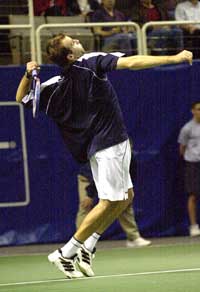 |
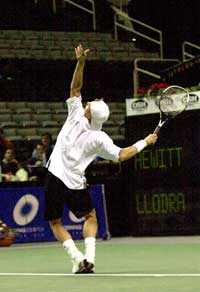 |
Does the Pinpoint Stance have any real advantage for servers such as Hewitt or Rusedski? |
|
In the
Myth of the Back Leg we exposed the myth that modern players step into
the serve with the back foot. What our high speed footage showed was that
virtually all good servers actually land on the front foot with the back leg
kicking backwards in the opposite direction.
This pattern of leg action, which I call “the coil and the hop,” results
from the deep knee bend in the modern game. But what about players who use
the so-called “Pinpoint Stance”?
In the Pinpoint Stance, players bring the back foot up underneath them
before they push off the court. We can contrast this motion to the “Platform
Stance” in which the back leg stays in position as the motion uncoils. This
is the stance used, for example, by Sampras and Agassi.
Is the Pinpoint a way to get even more power into the serve? Doesn’t it let
you push off with both feet?
Interestingly, players who use the Pinpoint end up finishing the motion in
exactly the same way as players using the Platform. After first bringing the
back leg forward, they all end up kicking the back leg back away from them
and landing in the court on the front foot.
So what’s the benefit of bringing the back foot forward, if it ends up
kicking it back the other way as the motion uncoils?
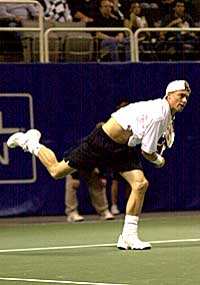 |
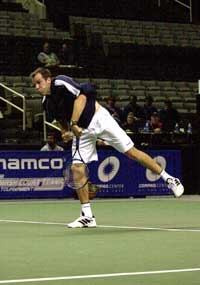 |
Players who use the Pinpoint Stanceall land on the front foot with the rear leg kicking backwards. |
|
The theory is that by bringing the back foot up, players can
actually push off with both legs, compared to the Platform where the push
comes from the front leg only. In theory using both legs increases the
positive benefits of the deep knee bend by increasing the transfer of energy
as the legs uncoil.
This is a commonly held belief in some sectors of the coaching and teaching
community. A recent high-tech book on stroke production declares that the
Pinpoint Stance actually produces more vertical lift and a higher contact
point as compared to the Platform Stance.
Well known pro players who use some version of the Pinpoint Stance include
world number one Lleyton Hewitt, as well as two of the game’s biggest
servers, Mark Philippoussis and Greg Rusedski. Does that extra step really
help their serves?
If we look closely at the high speed footage, I think the answer is
definitely no. None of the players mentioned above gets any discernible push
with the back leg.
The Pinpoint stance is at best irrelevant to the leg action in the modern
serve and in some cases, it may actually be a negative factor, restricting
the coiling action of the body, and impeding the transfer of energy into the
shot. This appears to be the case in the motion of Mark Philippoussis as we
shall see.
The Pinpoint is of course widely copied by junior and club players.
Unfortunately the extra motion in the Pinpoint often ends up causing them
all kinds of other technical problems. More than likely, if you are a player
currently using the Pinpoint Stance, you can make an almost immediate
improvement in the consistency and power of your serve by going to the
simpler and more powerful Platform Stance
|
Evaluating the benefits of the two stances and the role of the legs in
the serve is, however, a complex task. First, we can’t point to examples of
pro players going back and forth between the two stances so we can readily
compare results.
Second, to date we have not been able to measure the amount of muscle
contraction exerted at various points in the service motion, and this kind
of quantitative data might settle the argument more clearly than even the
high speed video.
Third, there are at least 3 different versions of the Pinpoint Stance. We’ll see that Rusedski, Hewitt, and Philippoussis all do slightly different things with the back leg. Do these different motions have the same or different effects?
Let’s analyze the leg action of theses top players, and see what Advanced Tennis high speed video (www.AdvancedTennis.com) allows us to see about how the stance works. What are the similarities and what are the differences among Rusedski, Hewitt and Philippoussis?
Greg Rusedski
The big claim about the Pinpoint is that it allows players
to push off with both legs, and to get greater vertical height. Greg
Rusedski holds the speed record on the pro tour at 149 mph, and he uses the
Pinpoint Stance.
Is the Pinpoint one reason why? Clearly in the case of Rusedski, no. The
Pinpoint is not helping him generate additional height or a higher contact
point.
|
Advanced Tennis studies comparing Pete Sampras to Rusedski show that both
players make contact at virtually identical heights - on average, 9’ 5”
above the court surface.
Rusedski, however, at 6’ 4” is 3” taller than Pete! So there’s no way the Pinpoint in and of itself could be giving him more lift. He actually appears to be losing rather than gaining height.
Why? Rusedski barely gets off the court surface at contact, while Pete is several inches in the air. Probably, this difference in contact has more to do with the knee bend than the Pinpoint Stance. Rusedski has the least knee bend of any of the top players and Pete has the most, or close to it.
If Rusedski had a deeper bend, he undoubtedly would get higher off the ground. But that would require a higher toss and a totally different tempo since his motion is very quick. But what about the role of the back leg? Even if he doesn’t have as much knee bend, is Rusedski getting any significant push by bringing the back foot up into the Pinpoint? Check out the Advanced Tennis high speed video and I think you’ll agree the answer is no.
Watch closely what happens to his legs. Rusedski begins his knee bend with the back leg still back. He only starts to bring the back leg up after his front leg reaches the deepest part of the bend. This turns out to be important
Want to see more high speed video of the serves of top players as well as other strokes? Click here for info on Advanced Tennis high speed digital videos. |
Note that as Rusedski moves his back foot up and into the Pinpoint, he
doesn’t drag his foot along the court surface. Instead he picks the back
foot up off the court and moves it forward in the air. When he does put it
down into the Pinpoint Stance, he puts it down toes first.
At this point, Rusedski appears, literally, to be standing up on the tiptoes
of his back leg. The ball of his back foot never makes contact with the
court. At the time he leaves the court, his back foot is virtually straight
up and down, or perpendicular to the court.
|
Watch closely and see if you can actually see any significant “push” from the back foot from this position. The feet appear to leave the court at almost exactly the same time. But look at the difference in the angle of the feet to the court surface. The ball of Rusedski’s front foot is on the court, and it’s obvious that this is where the push is coming from.
Compare that with the “tiptoes” position of the back foot. The push with the back leg appears to minimal if not non-existent. In my opinion, Rusedski’s back leg is actually passive. It’s irrelevant to the real bio-mechanics of the motion or the generation of power. The back leg just doesn’t appear to be pushing at all. Instead it is being pulled up and off the court by the forces generated by the uncoiling of front leg.
If you don’t believe me, try this simple test. First stand in the serve
ready position, drop into your knee bend position and push off as hard as
you can into the air with both feet. You’ll feel your heels leave the court
first, and the push come from the balls of your feet. See how high you get
in the air.
Now stand on your tiptoes and try the same thing. See how high you can get
in the air that way. Which way do you get more push from the legs? (See if
you can even get as far up on your toes as Rusedski, much less push off from
that position.)
So in Rusedski’s case, the role of the Pinpoint appears to be at best
irrelevant.
|
Last Updated 7/1/02. To contact us, please email to: webmaster@tennisone.com
TennisONE is a registered trademark of TennisONE and SportsWeb ONE; Copyright 1995. All rights reserved.


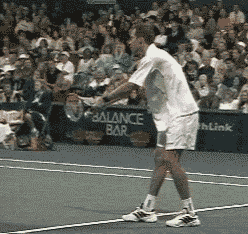
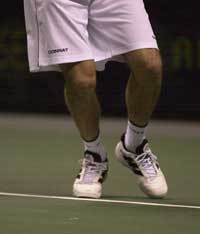
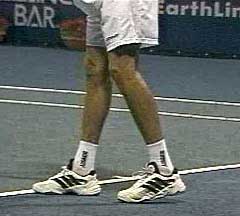
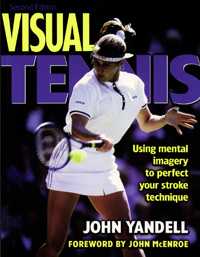 Visual
Tennis
Visual
Tennis